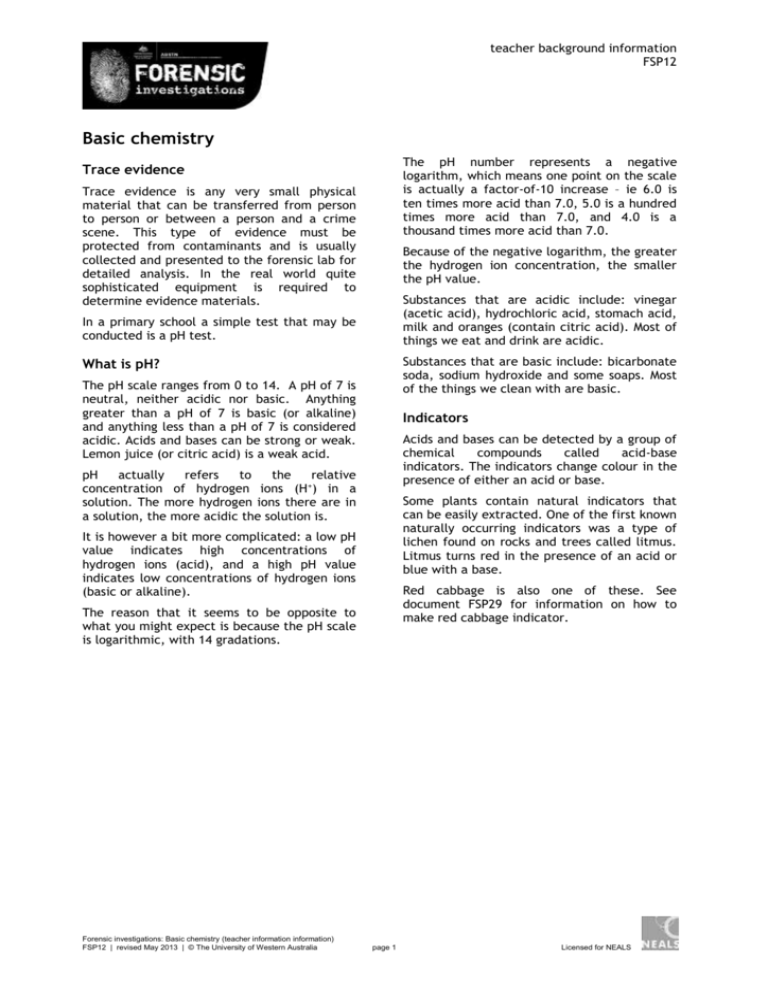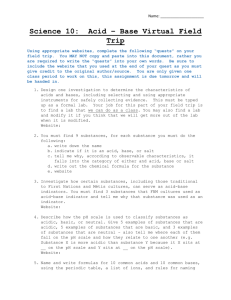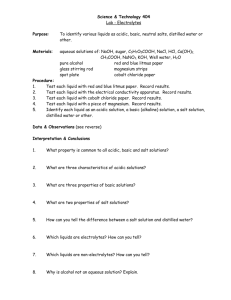Basic chemistry
advertisement

teacher background information FSP12 Basic chemistry The pH number represents a negative logarithm, which means one point on the scale is actually a factor-of-10 increase – ie 6.0 is ten times more acid than 7.0, 5.0 is a hundred times more acid than 7.0, and 4.0 is a thousand times more acid than 7.0. Trace evidence Trace evidence is any very small physical material that can be transferred from person to person or between a person and a crime scene. This type of evidence must be protected from contaminants and is usually collected and presented to the forensic lab for detailed analysis. In the real world quite sophisticated equipment is required to determine evidence materials. Because of the negative logarithm, the greater the hydrogen ion concentration, the smaller the pH value. Substances that are acidic include: vinegar (acetic acid), hydrochloric acid, stomach acid, milk and oranges (contain citric acid). Most of things we eat and drink are acidic. In a primary school a simple test that may be conducted is a pH test. Substances that are basic include: bicarbonate soda, sodium hydroxide and some soaps. Most of the things we clean with are basic. What is pH? The pH scale ranges from 0 to 14. A pH of 7 is neutral, neither acidic nor basic. Anything greater than a pH of 7 is basic (or alkaline) and anything less than a pH of 7 is considered acidic. Acids and bases can be strong or weak. Lemon juice (or citric acid) is a weak acid. Indicators Acids and bases can be detected by a group of chemical compounds called acid-base indicators. The indicators change colour in the presence of either an acid or base. pH actually refers to the relative concentration of hydrogen ions (H+) in a solution. The more hydrogen ions there are in a solution, the more acidic the solution is. Some plants contain natural indicators that can be easily extracted. One of the first known naturally occurring indicators was a type of lichen found on rocks and trees called litmus. Litmus turns red in the presence of an acid or blue with a base. It is however a bit more complicated: a low pH value indicates high concentrations of hydrogen ions (acid), and a high pH value indicates low concentrations of hydrogen ions (basic or alkaline). Red cabbage is also one of these. See document FSP29 for information on how to make red cabbage indicator. The reason that it seems to be opposite to what you might expect is because the pH scale is logarithmic, with 14 gradations. Forensic investigations: Basic chemistry (teacher information information) FSP12 | revised May 2013 | © The University of Western Australia page 1 Licensed for NEALS How is pH tested? There are a number of ways that scientists test for pH. Some provide more accurate pH readings than others. See the table below for a list of some of the available pH tests. TEST NAME WHAT FORM DOES IT COME IN? WHAT DOES IT DO? WHAT WILL IT WORK ON? DETAIL OF RESULTS acetic acid (vinegar) liquid It will react with solid bases that contain carbonate to produce carbon dioxide gas (it will fizz). If added to acid, nothing will happen. The liquid works on dry substances (powders) and liquids. Will only give a positive result to carbonates. Easy to use and very safe. universal indicator liquid or a paper strip It is a green indicator, and when added to the test substance it changes colour. There are ranges of colours that it will change to depending on pH of the substance you’re testing. The colour can be checked against a chart to find out the pH. The liquid works on dry substances (powders) and liquids. The paper only works on liquids. It only will give a range, not a precise pH. Easy to use. litmus paper paper strip There are two types of litmus paper. Red and blue. Blue stays blue if testing a base, but will change to red if testing an acid. Red does the opposite (red if acid – stay same, blue if base – changes colour). Only works on liquids. It will only tell if a substance is an acid or a base. No details on how acidic or basic. Easy to use. red cabbage indicator liquid The colour of red cabbage water will change depending on the pH of the test substance Works on dry substances (powders) and liquids. It only will give a range, not a precise pH. Easy to use. What is solubility? Solubility can be affected by other variables other than the substance itself. Solubility is the ability of a substance to dissolve into a liquid. The more easily and quickly it dissolves, generally the more soluble the substance is. An example of a very soluble substance is sugar in water. An example of a relatively insoluble substance is bicarbonate of soda in water. Forensic investigations: Basic chemistry (teacher information information) FSP12 | revised May 2013 | © The University of Western Australia page 2 Size of the particles you are trying to dissolve. For example: caster sugar with fine particles will dissolve faster than normal sugar that has larger particles. Temperature of the solvent or the liquid you are trying to dissolve the material into. For example: hot water will increase the speed of dissolving of sugar in water. Some definitions Solute: the solid material that is dissolved in the liquid. Solvent: the liquid that the solid (solute) is dissolved in. Solution: a liquid mixture of dissolved substances. White powder analysis In the case of determining the identity of an unknown substance, crime lab experts must use testing procedures that give characteristic results. These tests and their results must be established prior to the examination of the unknown substance. Once the tests are verified, they are recorded and used repeatedly to prove the identity of suspect substances. For example, if you want to determine if an unknown white powder is cocaine, you must have a previously established, positive test for cocaine. Then you can conduct this established test on an unknown white powder. It is also important to perform more than one positive test on an unknown. Proper identification requires that you use enough different tests to rule out the possibility that the unknown may be any other substance. For example, a lab technician may be testing an unknown white powder to determine whether or not it is cocaine. To be thorough, this technician will run a series of tests on the powder. If all tests are positive for cocaine, then the technician will feel certain that the results are correct. In the white powder analysis activity students will perform tests on some harmless white powders. After carrying out the tests they will refer to a ‘White Powder Key’ that lists the properties of a range of ‘white powder’ substances. Using the key they will try and determine what the substances are. After they have completed this activity they will be able to analyse the ‘crime scene’ powder and try to determine what it is. Forensic investigations: Basic chemistry (teacher information information) FSP12 | revised May 2013 | © The University of Western Australia page 3






